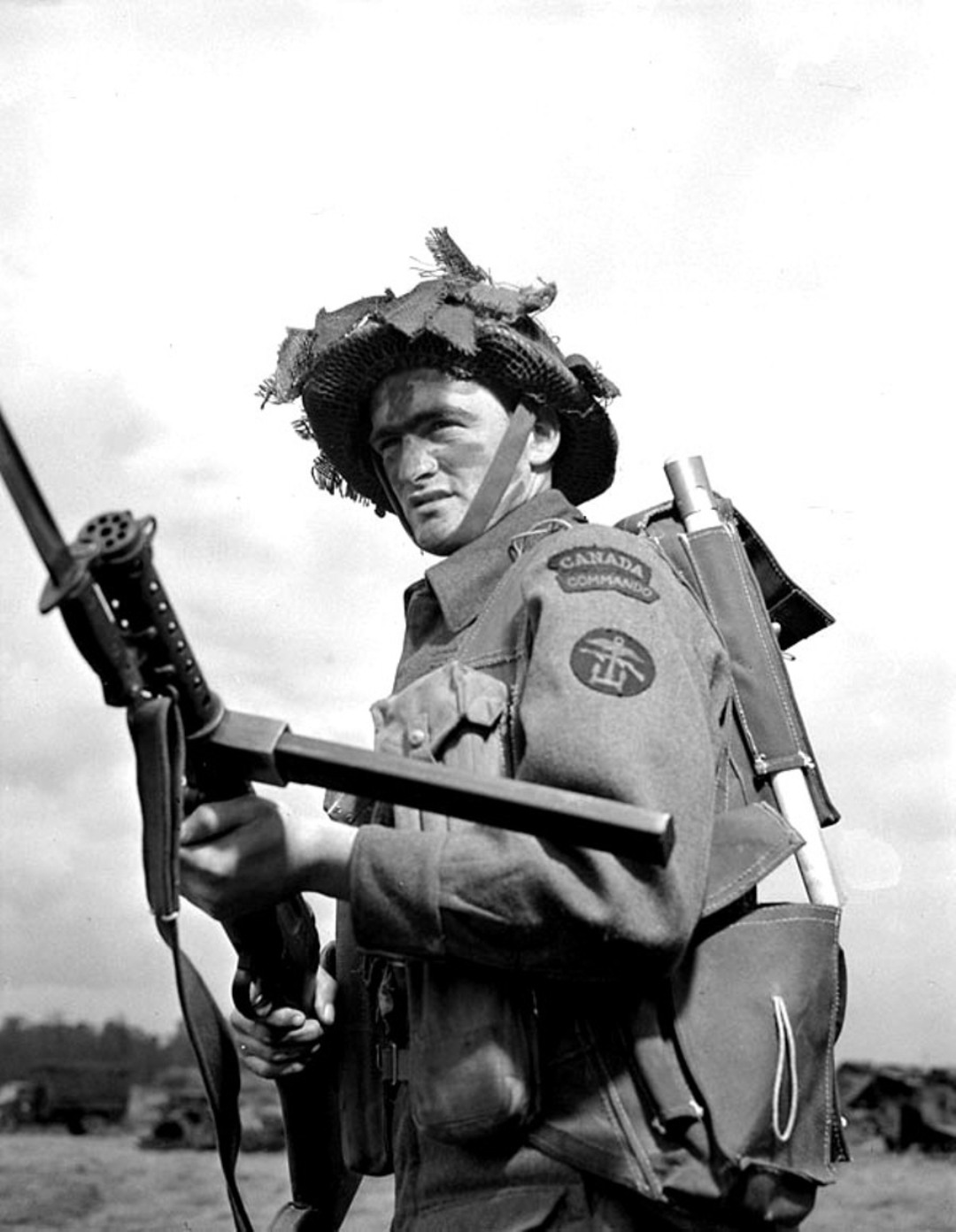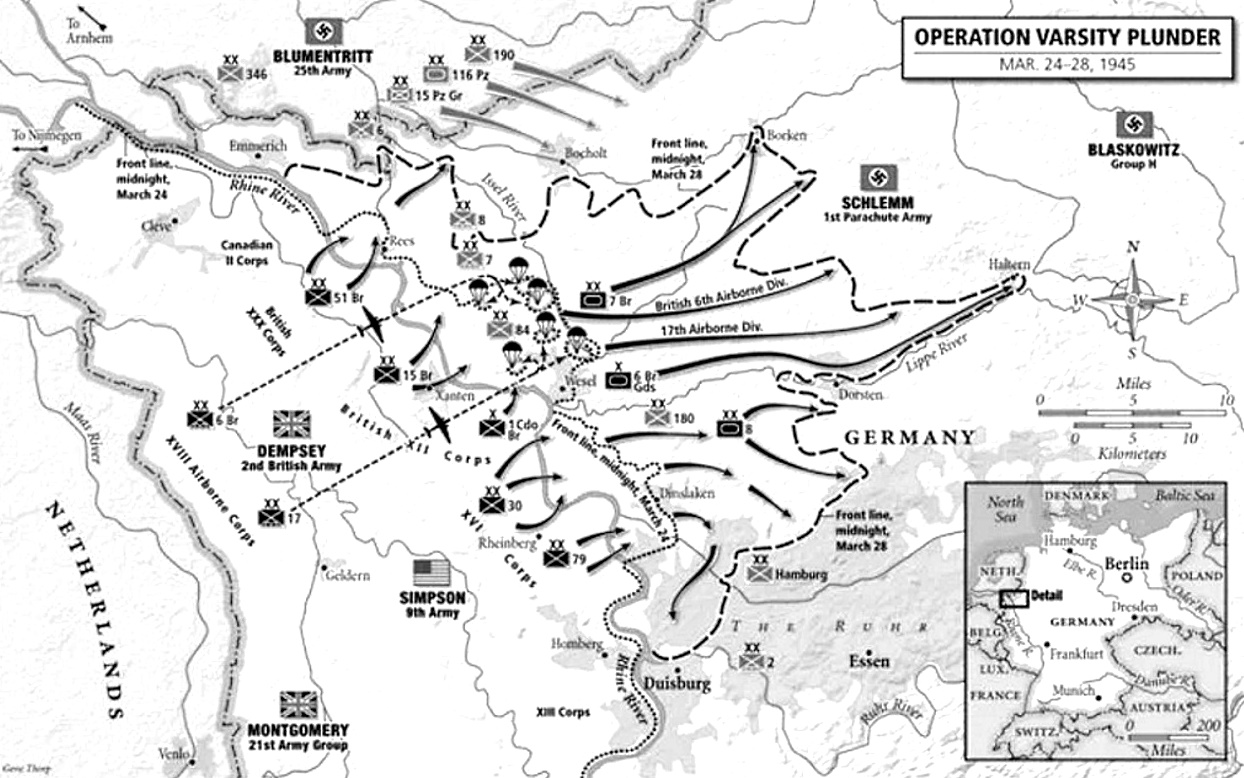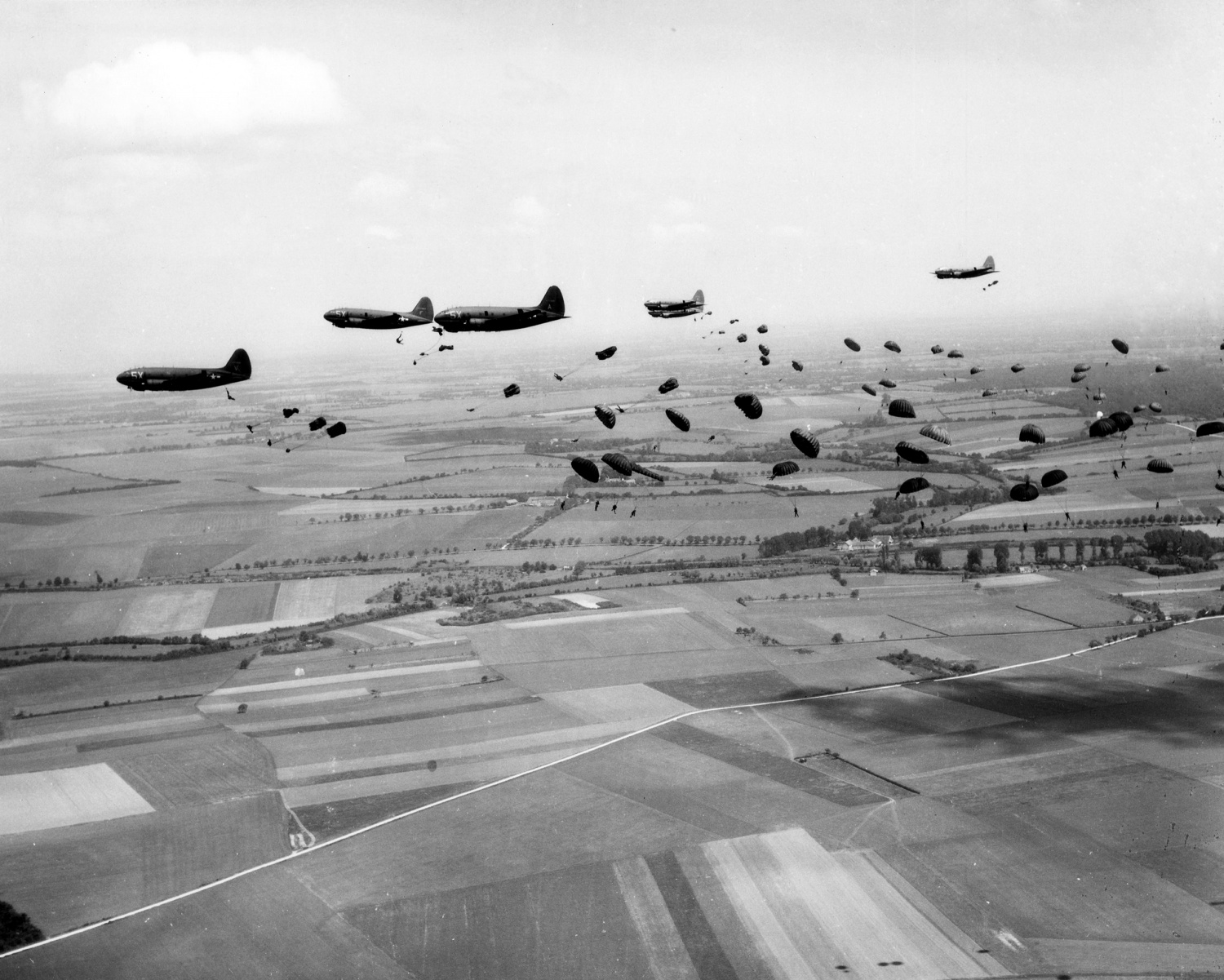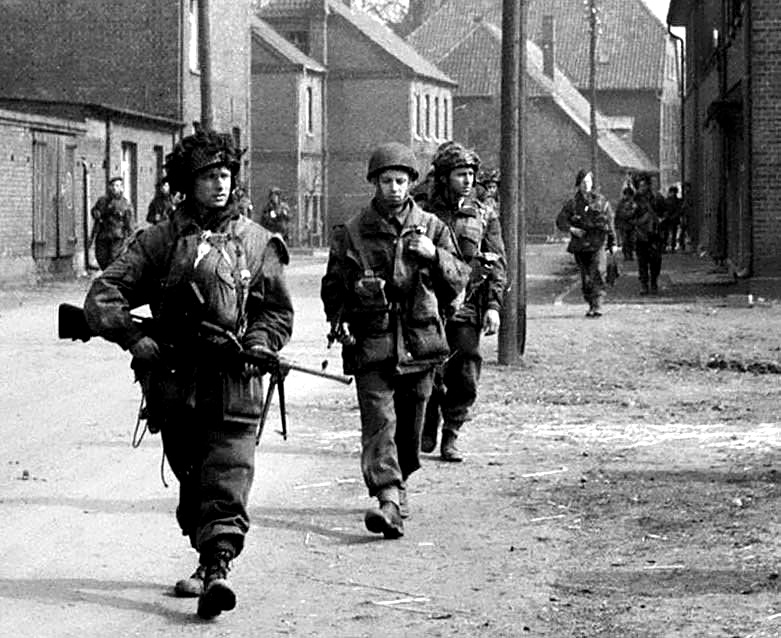Allied Plans for Crossing the Rhine
(26) Once the Germans had been defeated west of the Rhine, the Allies were in a strong position to assault the river and seize the vital Ruhr industrial region. The plan of the campaign for crossing the Rhine and establishing a strong force on the far bank was, thanks to the success of the operations west of the river, basically the same as that envisaged in our long-term planning in January, and even before D-day. Its fundamental features were the launching of a main attack to the north of the Ruhr, supported by a strong secondary thrust from bridgeheads in the Frankfurt area, directed initially on Kassel to complete the envelopment of the Ruhr. Subsequently, offensives would strike out from the bridgeheads to any remaining organized forces and complete their destruction. Since an attack could not be made on the Ruhr frontally, it was necessary to by-pass it and, although the south had several assaulting sites, the most suitable terrain for mobile operations lay to the north.

 (27) Operation Plunder, the name given to this great assault across the Rhine north of the Ruhr, was conducted by the British 21-AG with three Allied Armies under command. The plan in outline was to cross the Rhine on one front of two Armies between Rees and Rheinberg with the US 9-A on the right and the UK 2-A on the left. They were to capture the communications center of Wesel and then to expand their initial lodgement area on the east bank southward to a distance sufficient to secure the roads through Wesel from enemy ground action, northward to enable the river to be bridged at Emmerich, and eastward and northeastward
(27) Operation Plunder, the name given to this great assault across the Rhine north of the Ruhr, was conducted by the British 21-AG with three Allied Armies under command. The plan in outline was to cross the Rhine on one front of two Armies between Rees and Rheinberg with the US 9-A on the right and the UK 2-A on the left. They were to capture the communications center of Wesel and then to expand their initial lodgement area on the east bank southward to a distance sufficient to secure the roads through Wesel from enemy ground action, northward to enable the river to be bridged at Emmerich, and eastward and northeastward  to secure a firm bridgehead of adequate size from which further offensive operations could be developed. In the first stage of the operations, the principal task of the UK 2-A was to capture Wesel, while the US 9-A was to secure the right flank. The First Canadian Army, which had no active part in the assault, was made responsible for the absolute security of the Nijmegen bridgehead and of the entire northern flank from Emmerich to the sea. The second stage of operations involved the extension of the bridgehead eastwards and northwards.
to secure a firm bridgehead of adequate size from which further offensive operations could be developed. In the first stage of the operations, the principal task of the UK 2-A was to capture Wesel, while the US 9-A was to secure the right flank. The First Canadian Army, which had no active part in the assault, was made responsible for the absolute security of the Nijmegen bridgehead and of the entire northern flank from Emmerich to the sea. The second stage of operations involved the extension of the bridgehead eastwards and northwards.
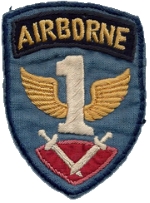
 (28) To assist the advance of UK 2-A, the 1-AAA (First Allied Airborne Army) was to drop the US XVIII Corps (A/B), comprising the US 17th Airborne Division and the UK 6th Airborne Division, approximately five miles north and northwest of Wesel to seize the key terrain in that area.
(28) To assist the advance of UK 2-A, the 1-AAA (First Allied Airborne Army) was to drop the US XVIII Corps (A/B), comprising the US 17th Airborne Division and the UK 6th Airborne Division, approximately five miles north and northwest of Wesel to seize the key terrain in that area.

 The tasks of the US XVIII Corps (Airborne) were to disrupt the hostile defenses north of Wesel, to deepen the bridgehead, and to facilitate the crossing of the river by the UK 2-A and its link-up with the US 9-A. It Was then to prepare for further offensive action to the east on orders from the UK 2-A. (Montgomery)
The tasks of the US XVIII Corps (Airborne) were to disrupt the hostile defenses north of Wesel, to deepen the bridgehead, and to facilitate the crossing of the river by the UK 2-A and its link-up with the US 9-A. It Was then to prepare for further offensive action to the east on orders from the UK 2-A. (Montgomery)
This airborne crossing of the Rhine to be made in conjunction with Operation Plunder, I was given the code-name Operation Varsity. Gen Milles Dempsey, who as Commander of UK 2-A was responsible for planning and executing the main thrust, met the airborne chiefs on Feb 20, to present his desired scheme for airborne support. He said he considered it absolutely essential to have airborne assistance in crossing the Rhine. The airborne mission was to be twofold: (1) seize the commanding ground from which artillery fire controlled the whole area and (2), block possible arrival of enemy reinforcements from east of Wesel. (Brereton).
Parachute descents hitherto had always heralded the main attack, but to provide an additional element of surprise Gen Dempsey persuaded the Commander-in-Chief to adopt a novel tactical variation in timing. It was decided to drop the airborne troops east of the Rhine after (sic) the assault across the river had taken place. There were two main reasons for this decision: daylight was desirable for the employment of airborne troops and, secondly, it would be impossible to make full use of our artillery for the ground assault if airborne troops were dropped in the target area before we had crossed the river. In deciding the landing and dropping zones for the airborne forces, the principles employed were that they should drop within range of artillery sited on the west bank of the Rhine, in order to obtain immediate artillery support, and that they link up with the ground troops should be effected on the first day of the operation. (Montgomery)

 (29) The tasks assigned to the Allied Air Forces were three in number and all were achieved with a high degree of success. Primarily, on February 21, 1945, both the Allied Strategic and Tactical Air Forces commenced their intensive campaign not only to isolate the immediate battle area but to cut off northwest Germany from effective ground and air reinforcements. As the target date for the assault approached, their attacks upon communications in the battle area intensified to an even greater degree. In addition, during the 72 hours preceding the assault, a number of attacks were made upon enemy barracks and camps in the vicinity of the planned bridgehead. Apart from the casualties inflicted in such attacks, it cannot be doubted that they produced a serious moral effect on the enemy, who, after enduring three days of unremitting hell from the air was in no condition to meet the frontal attack when it was launched. In all, during the 4 days, Feb 21-24, the American and British Air Forces, based in Britain, western Europe, and Italy, flew over 42.000 sorties against Germany. (Eisenhower)
(29) The tasks assigned to the Allied Air Forces were three in number and all were achieved with a high degree of success. Primarily, on February 21, 1945, both the Allied Strategic and Tactical Air Forces commenced their intensive campaign not only to isolate the immediate battle area but to cut off northwest Germany from effective ground and air reinforcements. As the target date for the assault approached, their attacks upon communications in the battle area intensified to an even greater degree. In addition, during the 72 hours preceding the assault, a number of attacks were made upon enemy barracks and camps in the vicinity of the planned bridgehead. Apart from the casualties inflicted in such attacks, it cannot be doubted that they produced a serious moral effect on the enemy, who, after enduring three days of unremitting hell from the air was in no condition to meet the frontal attack when it was launched. In all, during the 4 days, Feb 21-24, the American and British Air Forces, based in Britain, western Europe, and Italy, flew over 42.000 sorties against Germany. (Eisenhower)
Operation Varsity – March 1945 – General Area
Secondly, allied photographic recon aircraft provided the armies with extremely full and accurate intelligence information regarding flak areas, ground defenses and terrain suitability for dropping and landing zones. Lastly, the Allied Air Forces were responsible for the safe delivery of the men of the XVIII Corps (Airborne) to the battlefield. The chief threat of interference lay in jet aircraft (ME-262) in which the enemy had a superiority of production. This was neutralized by heavy bombing of jet airfields to destroy the planes on the ground, to crater the extra-long runways they required, and to blow up hoarded supplies of fuel. In addition, on the actual day of the assault two major diversionary raids over Berlin and certain oil and rail targets kept enemy fighters occupied elsewhere. On that day the Allied Air Forces flew some 8000 aircraft and 1300 glider sorties while sighting fewer than 100 enemy planes in the air. The culmination of all these efforts in the air is described by Gen Eisenhower in these words: as a result of the protection by fighter aircraft coupled with the measures taken against enemy airfields, not one transport was molested by hostile aircraft. Some losses were sustained from fire over the target, but the total of 46 planes destroyed (3.98 % of those employed) was remarkably low considering the fact that to ensure accuracy of dropping and landing, no evasive action was taken.
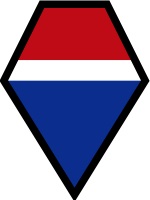
 (30) Use of airborne troops, air support, artillery, and amphibious equipment on the maximum scale was considered to be essential to ensure a successful passage of the main forces of infantry and armor across the river. By seizing unexpected opportunities, however, the US 12-AG accomplished two prior Rhine crossings in the south without formal preparations and with negligible losses. The seizure of the railway bridge at Remagen on March 7, was a factor of great significance in upsetting the enemy’s defensive scheme and in forwarding the plans of the Allies for encircling the Ruhr. A surprise night crossing south of the Rhine just as the Allies were about to launch their carefully-prepared power drive in the north impressed upon both sides the fact that a bridgehead there would inevitably result in the collapse of Germany’s powers of resistance.
(30) Use of airborne troops, air support, artillery, and amphibious equipment on the maximum scale was considered to be essential to ensure a successful passage of the main forces of infantry and armor across the river. By seizing unexpected opportunities, however, the US 12-AG accomplished two prior Rhine crossings in the south without formal preparations and with negligible losses. The seizure of the railway bridge at Remagen on March 7, was a factor of great significance in upsetting the enemy’s defensive scheme and in forwarding the plans of the Allies for encircling the Ruhr. A surprise night crossing south of the Rhine just as the Allies were about to launch their carefully-prepared power drive in the north impressed upon both sides the fact that a bridgehead there would inevitably result in the collapse of Germany’s powers of resistance.
 (31) Intelligence reports revealed that the UK 21-AG was faced on the east bank by the German 1.Fallschirmjäger-Armee (Airborne Army), with the 2.Fallschirmjäger-Korps in the north, the 86.Korps in the center, and the 63.Korps in the south. In Army reserve the 47.Panzer-Korps lay up behind the Paratroopers in the north, thereby indicating the area of greatest enemy apprehension. (The Concluding Phase: the advance into north-west Germany and the Final Liberation of the Netherlands, March 23, 1945, – May 5, 1945)
(31) Intelligence reports revealed that the UK 21-AG was faced on the east bank by the German 1.Fallschirmjäger-Armee (Airborne Army), with the 2.Fallschirmjäger-Korps in the north, the 86.Korps in the center, and the 63.Korps in the south. In Army reserve the 47.Panzer-Korps lay up behind the Paratroopers in the north, thereby indicating the area of greatest enemy apprehension. (The Concluding Phase: the advance into north-west Germany and the Final Liberation of the Netherlands, March 23, 1945, – May 5, 1945)
(32) The land assault by the UK 21-AG was timed to begin at 2100, March 23 (D-1), the initial parachute drop at 1000, March 24 (P hour). Almost 3000 guns were massed along the Rhine to support the ground and air onslaught. The offensive was heralded, at 2000, on March 23, with a great artillery barrage of an hour’s duration, directed against the east bank of the Rhine and extending through the zone where the airborne forces were to be dropped and landed on the next day. (Eisenhower).
The airborne operation necessitated an elaborate counter-flak fire plan synchronized with close air cooperation. Its complications were greatly increased by the decision to time the air assault some 12 hours after the ground attack. It was arranged that artillery would deal with enemy AAA guns within range and that the RAF should undertake the neutralization of guns beyond this area which could engage the troop carriers and gliders. Very detailed arrangements were necessary for the control of artillery fire during the passage of the airborne fleets. (Montgomery).
Prior to the P-hour field, medium, heavy, and super-heavy artillery firing over the heads of the attacking ground forces laid down a devastating barrage extending through the landing zones and dropping zones. Its schedule was as follows: P-2 hours to P-1 hour – Targets, Counter-battery, and softening bombardment. P-30 mins to P-15 mins – Targets, AAA Guns bombardment. P-15 mins to P-00 – Targets, Counter-battery, and softening bombardment.
(33) In order to conceal the ground build-up, FM Montgomery screened his activity by the extensive use of smoke on a fifty-mile front (American Observers’ Report). No comparable cloak could hide from the enemy the fact that a large-scale air operation was intended, however, as military men could easily interpret the pattern of Allied air attacks and various other factors together with information obtained through Intelligence channels.
 Axis Sally, the well-known Berlin radio commentator announced on March 22: Allied airborne landings on a large scale to establish bridgeheads east of the Rhine River must be expected. The point is that until the actual descent began the Germans did not know just where and when the battle would be joined. Captured documents reveal the fact that the German High Command expected the Airborne landing farther north at Emmerich and had concentrated considerable flak in this area.
Axis Sally, the well-known Berlin radio commentator announced on March 22: Allied airborne landings on a large scale to establish bridgeheads east of the Rhine River must be expected. The point is that until the actual descent began the Germans did not know just where and when the battle would be joined. Captured documents reveal the fact that the German High Command expected the Airborne landing farther north at Emmerich and had concentrated considerable flak in this area.
Operation Varsity, 1st Canadian Parachute Battalion
 (34) Upon the XVIII Corps (Airborne) being designated as task force for Operation Varsity, orders had been issued for the US 17-A/B to concentrate in France and the British 6-AB in England. Soon after arriving the personnel of the 1-CPB was informed by the Commanding Officer of the reason for the unit returning to the UK. Training for the forthcoming operation did not begin, however, until after all ranks returned from seven days’ leave ending March 7, 1945. The Battalion was then up to full strength in Officers and other ranks with the exception of a deficiency of 14 sergeants covered off by 8 surpluses of junior NCOs. Maj P.R. Griffin resumed command of Able Co from Capt J.A. Clancy; other senior regimental officers remained unchanged. Apart from the paymaster, the officers ranged in age from 22 to 30 years; the CO was 30, the youngest company commander 26, the padre and MO were 29 and 27 respectively, and were qualified paratroopers.
(34) Upon the XVIII Corps (Airborne) being designated as task force for Operation Varsity, orders had been issued for the US 17-A/B to concentrate in France and the British 6-AB in England. Soon after arriving the personnel of the 1-CPB was informed by the Commanding Officer of the reason for the unit returning to the UK. Training for the forthcoming operation did not begin, however, until after all ranks returned from seven days’ leave ending March 7, 1945. The Battalion was then up to full strength in Officers and other ranks with the exception of a deficiency of 14 sergeants covered off by 8 surpluses of junior NCOs. Maj P.R. Griffin resumed command of Able Co from Capt J.A. Clancy; other senior regimental officers remained unchanged. Apart from the paymaster, the officers ranged in age from 22 to 30 years; the CO was 30, the youngest company commander 26, the padre and MO were 29 and 27 respectively, and were qualified paratroopers.
(35) Training of personnel began with Ts.O.E.T. (Tests of Elementary Training) on all weapons, followed by field firing exercises and battle drills. Lack of time, the need for equipment elsewhere, and the necessity of keeping accidents to a minimum in the final stages prohibited divisional or brigade manœuvres. There was no opportunity to hold even a single practice descent, which meant that the majority of the men in the Battalion had not jumped since Exercise Eve in November 1944. Events moved very rapidly indeed. On March 19, large packs had to be handed in for shipment overseas, and thereafter all personnel was confined to the barracks for the remainder of the unit’s stay in England. The next morning the Division moved off by lorry to east Anglia. Hq 3d Paratroopers Brigade, 8th Parachute Battalion, 1st Canadian Parachute Battalion, and a detachment of 224th Paratroopers Field Ambulance were accommodated in the Hill Hall Transit Camp, England, and Wales, and were to emplane together at the airfield of Chipping Ongar.
(36) For the past three days the Intelligence Section had been preparing plasticine models and enlargements of maps and air photographs for use in briefing the Battalion at the camp. This commenced on March 21, with Lt Col Nicklin giving a general briefing to all personnel of the unit followed by a special briefing of officers. Two whole days were devoted to a detailed briefing by company and platoon commanders. For this purpose, the unit was allotted one hut to show Corps, Divisional, and Brigade plans plus two huts for the Battalion plan.
 (37) The general tasks allotted to the XVIII Corps (Airborne) in cooperation with the British 12th Corps on the ground have already been described in this report (see #28). That of the British 6-A/B was to seize, clear, and hold the Schnepfenberg (Wesel) feature, and the village of Hamminkeln (Wesel) together with the designated bridges over Issel River. These three bridges, all east of Hamminkeln (Wesel), were to be prepared for demolition but not blown unless recapture by the enemy became certain.
(37) The general tasks allotted to the XVIII Corps (Airborne) in cooperation with the British 12th Corps on the ground have already been described in this report (see #28). That of the British 6-A/B was to seize, clear, and hold the Schnepfenberg (Wesel) feature, and the village of Hamminkeln (Wesel) together with the designated bridges over Issel River. These three bridges, all east of Hamminkeln (Wesel), were to be prepared for demolition but not blown unless recapture by the enemy became certain.








